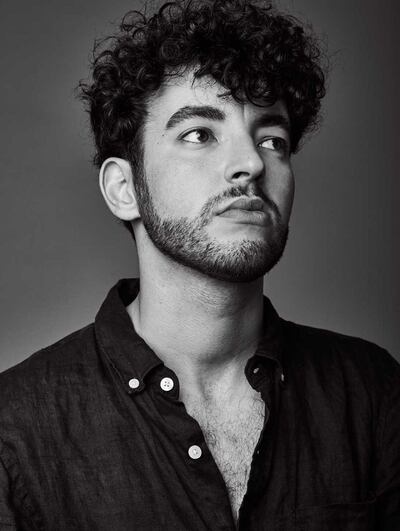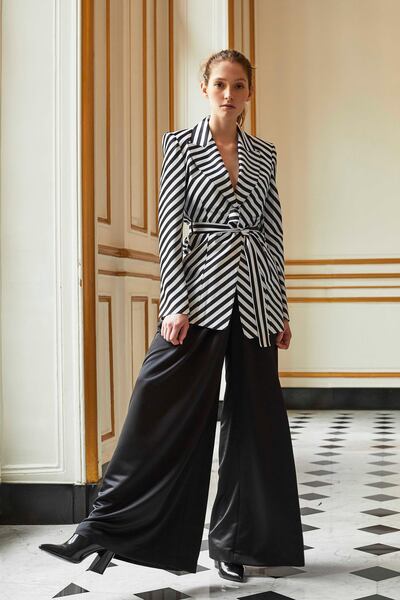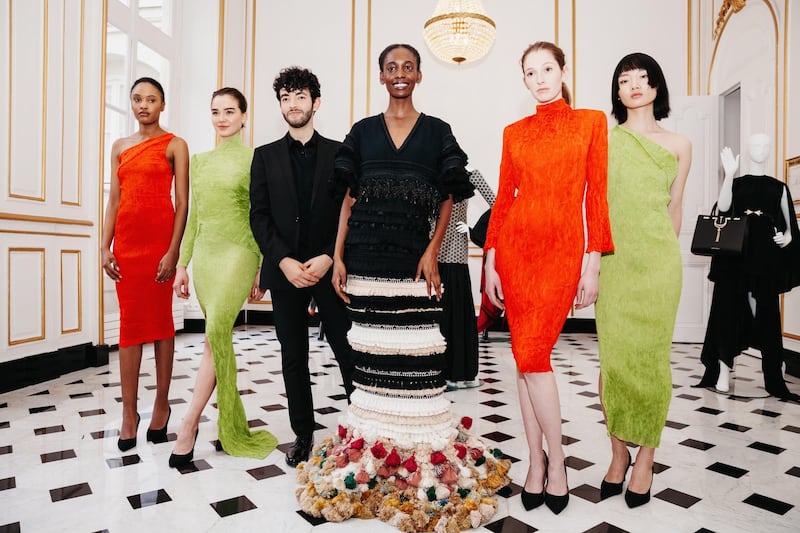Is that restless Berber spirit hardwired into Karim Adduchi's psyche? Based in Amsterdam, the artist and designer is talking about a potential move to Paris, to boost his young eponymous fashion label. "I think that if you are an artist, writer, musician or designer, your eye has to be travelling," suggests Adduchi, who was born in Morocco and raised in Spain. "You have to draw on personal experience. There are many designers where you see their life story reflected in their work."
Judging by the examples displayed on the mannequins and models around him in an elegant hotel ballroom on Paris’s Rue de Rivoli, Adduchi’s personal experience has definitely filtered into his designs, especially in the intricate couture pieces that reference his Arab heritage.

The 30-year-old designer spent his early childhood listening to the sounds of his mother's sewing machine in the courtyard of the family home in Imzouren, northern Morocco, where he was born. Only three generations ago, his forebears were nomadic ("certainly into the 1940s"), and the Berber culture is part of his fashion DNA. "It has to be," he says. "I prefer to show who I am, rather than who I could be."
Listed last year in the prestigious Forbes 30 under 30: Europe Art and Culture list, Adduchi is in Paris to present a line of more commercial ready-to-wear looks. They span neon-bright Fortuny-pleated dresses, wide-legged trouser suits and slim coat dresses with handwoven fringed detailing. It is his fourth collection and he has called it Maktub, which he translates as: “It is written – like your destiny is written in stone.”
It is a weighty promise to put on a collection, yet it is those amazing dresses and kaftans reflecting his Berber heritage that grab your attention – from a billowing red silk scarf dress to an earthy-coloured wrap jacket lavishly embroidered with turquoise and coral beads, and a Moroccan-style top and skirt trimmed with tassels and braids sourced from cities across his homeland.
There are also accessories: handbags made in Milan and trimmed with hardware inspired by symbols from the Berber culture.
Adduchi's past three couture collections, including his graduation collection from the Gerrit Rietveld Academie in 2015, were shown at Mercedes-Benz Amsterdam Fashion Week and are now held by private collectors and museums (notably those specialising in African culture), and even displayed as installations in hotel lobbies. They are artisanal designs. He works with two immigrant Syrian tailors in Amsterdam and a woman based in a remote part of Morocco who produces a specific local style of embroidery for him, while a man in Tetouan produces the gold metallic feathers that rustle on the sleeves of a cream jacket.
The designer also uses handwoven Moroccan textiles, which he moulds on the mannequin by hand when designing.
There is one striped dress that, he explains, was inspired by his mother’s tailoring. The stripes are not aligned, but point in different directions, reminiscent of the way his mother would cut pattern pieces from a length of cloth, using every scrap of material that she could. Times were tough. “It was a hard way of working. My mother would make a dress in exchange for a pot of milk.”

The fabrics, the silhouettes, the atmosphere – they evoke memories and are part of his storytelling, a way of separating his label from other brands. “I look to the past not with nostalgia, because you have to know where you come from before you know where you can go,” he says philosophically. He thinks very deeply about what he is doing and who he is designing for – the women that he knows, Arab women. He describes the collection as created not for several women, but the different phases and moments of one woman. “She can be fragile, dramatic, wistful, but also very strong.”
No doubt, this is a reflection of the women who surrounded him in his youth. He grew up between the sewing machines of his parents, who were both tailors. But his father moved to Barcelona to find better-paid work when Adduchi was just seven months old. He didn't meet his father properly until he was five, when the family joined him in Spain in 1993.
Speaking neither Catalan nor Spanish, Adduchi withdrew into a fantasy world of drawing. His talent was spotted early, and he was sent to art school and eventually to pursue fine arts at the University of Barcelona, where he lost himself in the world of Modigliani, Giacometti and the Renaissance artists. In his 20s, he survived by doing portraits, abstract and figurative work: "It was always very personal; you could recognise my style."
His father found work with a magazine distributor and would bring home fashion magazines that inspired the young artist. With time, and funded by his painting, Adduchi moved to Amsterdam to study fashion at Gerrit Rietveld. He didn’t speak Dutch, but he had learnt English through his love of literature.
After designing one collection in isolation, he realised he needed to work with collaborators, and through his work teaching refugees at a foundation in Amsterdam, Adduchi has trained tailors to work with him. He has also worked with children distressed by their experiences of war, showing them how to interpret their life stories through painting, drawing and fashion. “Fashion has a loud voice and if the message is important, then fashion can be a powerful tool,” he says.
It is these collaborations that he finds most rewarding. He would much rather travel to a remote part of Morocco to work with a local artisan than communicate with a clothing manufacturer in Italy via WhatsApp. “By doing this, I am giving something back to my people,” he says. “It gives me the drive and energy to continue.”







